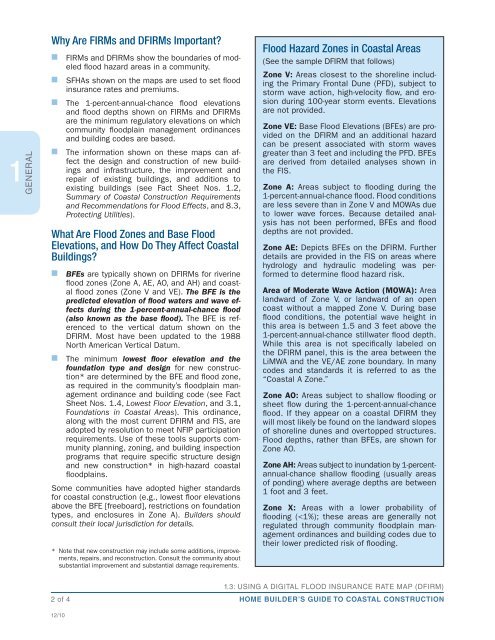FEMA P-499: Home Builder's Guide to Coastal Construction
FEMA P-499: Home Builder's Guide to Coastal Construction
FEMA P-499: Home Builder's Guide to Coastal Construction
You also want an ePaper? Increase the reach of your titles
YUMPU automatically turns print PDFs into web optimized ePapers that Google loves.
1<br />
GENERAL<br />
Why Are FIRMs and DFIRMs Important?<br />
n FIRMs and DFIRMs show the boundaries of modeled<br />
flood hazard areas in a community.<br />
n SFHAs shown on the maps are used <strong>to</strong> set flood<br />
insurance rates and premiums.<br />
n The 1-percent-annual-chance flood elevations<br />
and flood depths shown on FIRMs and DFIRMs<br />
are the minimum regula<strong>to</strong>ry elevations on which<br />
community floodplain management ordinances<br />
and building codes are based.<br />
n The information shown on these maps can affect<br />
the design and construction of new buildings<br />
and infrastructure, the improvement and<br />
repair of existing buildings, and additions <strong>to</strong><br />
existing buildings (see Fact Sheet Nos. 1.2,<br />
Summary of <strong>Coastal</strong> <strong>Construction</strong> Requirements<br />
and Recommendations for Flood Effects, and 8.3,<br />
Protecting Utilities).<br />
What Are Flood Zones and Base Flood<br />
Elevations, and How Do They Affect <strong>Coastal</strong><br />
Buildings?<br />
n BFEs are typically shown on DFIRMs for riverine<br />
flood zones (Zone A, AE, AO, and AH) and coastal<br />
flood zones (Zone V and VE). The BFE is the<br />
predicted elevation of flood waters and wave effects<br />
during the 1-percent-annual-chance flood<br />
(also known as the base flood). The BFE is referenced<br />
<strong>to</strong> the vertical datum shown on the<br />
DFIRM. Most have been updated <strong>to</strong> the 1988<br />
North American Vertical Datum.<br />
n The minimum lowest floor elevation and the<br />
foundation type and design for new construction*<br />
are determined by the BFE and flood zone,<br />
as required in the community’s floodplain management<br />
ordinance and building code (see Fact<br />
Sheet Nos. 1.4, Lowest Floor Elevation, and 3.1,<br />
Foundations in <strong>Coastal</strong> Areas). This ordinance,<br />
along with the most current DFIRM and FIS, are<br />
adopted by resolution <strong>to</strong> meet NFIP participation<br />
requirements. Use of these <strong>to</strong>ols supports community<br />
planning, zoning, and building inspection<br />
programs that require specific structure design<br />
and new construction* in high-hazard coastal<br />
floodplains.<br />
Some communities have adopted higher standards<br />
for coastal construction (e.g., lowest floor elevations<br />
above the BFE [freeboard], restrictions on foundation<br />
types, and enclosures in Zone A). Builders should<br />
consult their local jurisdiction for details.<br />
* Note that new construction may include some additions, improvements,<br />
repairs, and reconstruction. Consult the community about<br />
substantial improvement and substantial damage requirements.<br />
2 of 4<br />
12/10<br />
Flood Hazard Zones in <strong>Coastal</strong> Areas<br />
(See the sample DFIRM that follows)<br />
Zone V: Areas closest <strong>to</strong> the shoreline including<br />
the Primary Frontal Dune (PFD), subject <strong>to</strong><br />
s<strong>to</strong>rm wave action, high-velocity flow, and erosion<br />
during 100-year s<strong>to</strong>rm events. Elevations<br />
are not provided.<br />
Zone VE: Base Flood Elevations (BFEs) are provided<br />
on the DFIRM and an additional hazard<br />
can be present associated with s<strong>to</strong>rm waves<br />
greater than 3 feet and including the PFD. BFEs<br />
are derived from detailed analyses shown in<br />
the FIS.<br />
Zone A: Areas subject <strong>to</strong> flooding during the<br />
1-percent-annual-chance flood. Flood conditions<br />
are less severe than in Zone V and MOWAs due<br />
<strong>to</strong> lower wave forces. Because detailed analysis<br />
has not been performed, BFEs and flood<br />
depths are not provided.<br />
Zone AE: Depicts BFEs on the DFIRM. Further<br />
details are provided in the FIS on areas where<br />
hydrology and hydraulic modeling was performed<br />
<strong>to</strong> determine flood hazard risk.<br />
Area of Moderate Wave Action (MOWA): Area<br />
landward of Zone V, or landward of an open<br />
coast without a mapped Zone V. During base<br />
flood conditions, the potential wave height in<br />
this area is between 1.5 and 3 feet above the<br />
1-percent-annual-chance stillwater flood depth.<br />
While this area is not specifically labeled on<br />
the DFIRM panel, this is the area between the<br />
LiMWA and the VE/AE zone boundary. In many<br />
codes and standards it is referred <strong>to</strong> as the<br />
“<strong>Coastal</strong> A Zone.”<br />
Zone AO: Areas subject <strong>to</strong> shallow flooding or<br />
sheet flow during the 1-percent-annual-chance<br />
flood. If they appear on a coastal DFIRM they<br />
will most likely be found on the landward slopes<br />
of shoreline dunes and over<strong>to</strong>pped structures.<br />
Flood depths, rather than BFEs, are shown for<br />
Zone AO.<br />
Zone AH: Areas subject <strong>to</strong> inundation by 1-percentannual-chance<br />
shallow flooding (usually areas<br />
of ponding) where average depths are between<br />
1 foot and 3 feet.<br />
Zone X: Areas with a lower probability of<br />
flooding (


